Design Criteria For Robust And Secure Next Generation CPV Con-trol Systems
Conference: Internationaler ETG-Kongress 2013 – Energieversorgung auf dem Weg nach 2050 - Symposium 1: Security in Critical Infrastructures Today
11/05/2013 - 11/06/2013 at Berlin, Deutschland
Proceedings: Internationaler ETG-Kongress 2013 – Energieversorgung auf dem Weg nach 2050
Pages: 8Language: englishTyp: PDF
Personal VDE Members are entitled to a 10% discount on this title
Authors:
Benoit, Pascal; Rohbogner, Gregor; Kohrs, Robert; Wittwer, Christof (Fraunhofer Institute for Solar Energy Systems ISE, Heidenhofstr. 2, 79110 Freiburg, Germany)
Fey, Simon (Offenburg University of Applied Sciences, Badstr. 24, 77652 Offenburg, Germany)
George, Dicken; Wuellner, Johannes; Gombert, Andreas (Soitec Solar GmbH, Bötzinger Str. 31, 79111 Freiburg, Germany)
Abstract:
The design of control systems of concentrator photovoltaic power plants will be more challenging in the future. Reasons are cost pressure, the increasing size of power plants, and new applications for operation, monitoring and maintenance required by grid operators, manufacturers and plant operators. Concepts and products for fixed-mounted photovoltaic can only partly be adapted since control systems for concentrator photovoltaic are considerable more complex due to the required high accurate sun-tracking. In order to assure reliable operation during a lifetime of more than 20 years, robustness of the control system is one crucial design criteria. This work considers common engineering technics for robustness, safety and security. Potential failures of the control system are identified and their effects are analyzed. Different attack scenarios are investigated. Outcomes are design criteria that encounter both: failures of system components and malicious attacks on the control system of future concentrator photovoltaic power plants. Such design criteria are a transparent state management through all system layers, self-tests and update capabilities for security concerns. The findings enable future research to develop a more robust and secure control system for concentrator photovoltaics when implementing new functionalities in the next generation.


